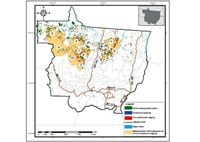 Read here the first forest management report for the state of Mato Grosso.
Read here the first forest management report for the state of Mato Grosso.
Monteiro, A., Conrado, D., Cardoso, D., Veríssimo, A. & Souza Jr., C. 2011.
In this first bulletin Transparency in Forest Management in Mato Grosso we assess the logging situation in the State. To do this, we first verified the regularity or consistency of the information on management plans in the Timber Harvesting Authorizations (Autorizações de Exploração Florestal – Autex) and authorized credits from logging issued by the State Secretariat for the Environment in Mato Grosso (Sema), from 2006 to 2009. We found that in 2009 the great majority (82%) of Autex plans were legally compliant, while 18% had inconsistencies, such as: i) area authorized in already deforested area; ii) area authorized in already logged area; iii) area authorized greater than the total managed area; iv) timber credit commercialized greater than authorized; and v) timber credit authorized without management plan. Of the years assessed, 2008 was the one presenting the greatest proportion of Autex plans with irregularities.
Our assessment also involved estimating the areas logged both legally (authorized) and illegally (not authorized) from August, 2007 to July, 2008 and August, 2008 to July, 2009, using NDFI images derived from Landsat images. The results reveal that of the 460,134 hectares of forests logged in the two periods together, 61% (280,979 hectares) were authorized by Sema as opposed to 39% (179,155 hectares) that were not authorized. In terms of illegal logging, the great majority (93%) occurred in areas that were private, vacant or disputed; another 6% occurred in Protected Areas; and 1% occurred in land reform settlements. For the two periods we observed a 57% reduction in illegal logging (70,922 hectares) and a positive increase of 76% (77,405 hectares) in legal logging.
Finally, we evaluated the quality of forest management performance in the State from August, 2007 to July, 2008 and August, 2008 to July, 2009 using NDFI images. We observed that good quality timber harvesting increased only 8% (one thousand hectares) between the two periods, while there were significant increases of 35% and 59% in intermediate (32,000 hectares) and low (44,000 hectares) quality logging, respectively. When we analyzed the satellite images for 2009, we found that in 99% of the forest management areas evaluated in the study periods the forest was maintained, while in only 1% of those areas did deforestation occured (clear cutting).
For a general assessment of timber harvesting in the State, we utilized information from forest control systems at Sema: Simlam (Integrated System for Environmental Licensing and Monitoring – Sistema Integrado de Licenciamento e Monitoramento Ambiental) and Sisflora (System for Marketing and Transportation of Forest Products – Sistema de Comercialização e Transporte de Produtos Florestais), overlapped with information generated by Simex (System for Monitoring Timber Harvesting – Sistema de Monitoramento da Exploração Madeireira), developed by Imazon (Box 1).
Download the file here
